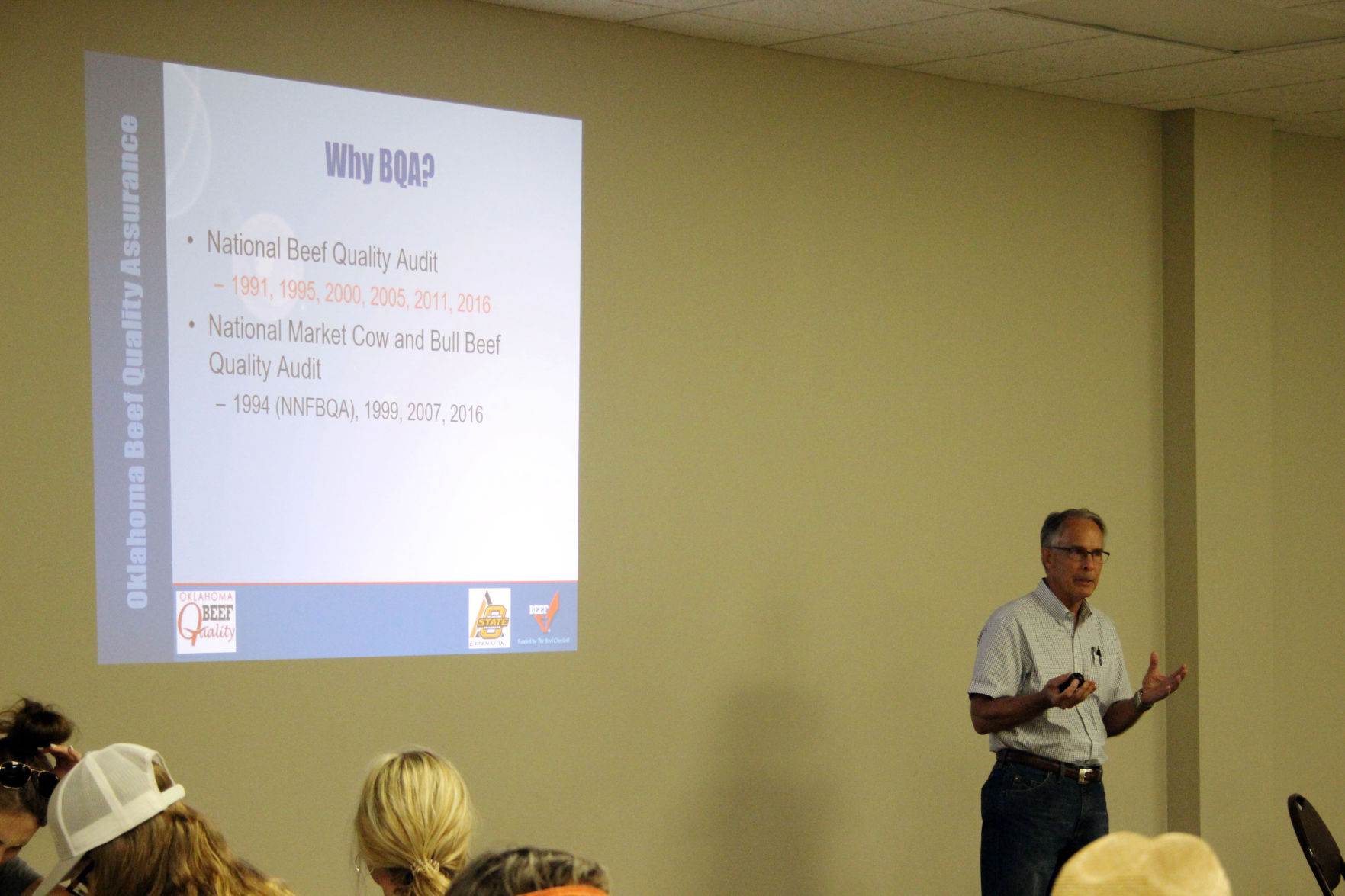Beef Quality Assurance programs continue to add value to beef industry

Beef Quality Assurance, a nationally coordinated and state-instigated cattle husbandry, wellness and record keeping program, continues to draw new cattlemen to receive certification and assists the beef industry in providing a more consistent product to consumers.
The BQA certification program started in 1982 and is a value-added program cattlemen can use to market their livestock and provide additional data about their cattle to potential buyers. Cattlemen attend educational meetings to learn about cattle health, management and defects to avoid that eat into profits at slaughter. They take a quiz based on the information from the meeting to become certified.
“It costs $1 to prevent a defect on an animal, while it costs $10 to fix a defect at manufacturing and $100 or more to fix a defect for customers,” said Bob LeValley, Oklahoma Beef Council director of compliance.
Carcasses can incur defects from branding, injection sites, bruises and quality issues. Placement of brand on the hide can be costly for slaughter houses to fix if the brand is placed over the ribs. LeValley recommends branding the hip to avoid this defect.
Dark cutters are the result of preharvest stress, which depletes muscle glycogen stores. The result is a dark, firm and dry carcass that is undesirable to customers. LeValley says low stress animal handling techniques are the best way to prevent dark cutter outcomes.
According to BQA, more than 38% of fed-beef, 64% of market cows and 42% of bull carcasses exhibit bruising. Producers should handle cattle gently and remove objects that could injure cattle. LeValley says although bruising has increased since the program started, the bruising is less severe which means less costly defects.
As far as carcass characteristics, LeValley says quality grade issues, such as inadequate marbling, cost the producer $15.75 per head. Yield grade issues such as excessive fat and inadequate muscling cost $12.91 per head.
Proper pharmaceutical handling and biosecurity
A strict set of rules exists for managing animal health and if some of the guidelines are skirted, cattlemen are likely to see the consequences when the carcasses hit the rail. Tommy Puffinbarger, Alfalfa County, Oklahoma, Extension educator, says it is important to always follow label instructions. Labels explain what the product should be used for as well as the recommended dosage and how the product should be stored.
The proper routes of administration for each medication, which include intramuscular, intravenous, subcutaneous, orally and topical, must be observed. Puffinbarger says subcutaneous administration is always preferred over intramuscular, if the labels permits, because of tissue reaction. Intramuscular and subcutaneous injections are to be given in the neck region; avoiding the shoulder and neck vertebra is crucial.
“Use one-half or three-quarter inch needles and don’t inject any more than 10 cc per injection site unless it says it on the label,” Puffinbarger said. “Needles should be changed every 10 to 15 head unless they become bent or contaminated. Never introduce a dirty or used needle into a bottle of vaccine or medicine.”
Dirty needles can transmit diseases such as anaplasmosis, which can devastate a herd.
Puffinbarger says although cleaning medical supplies is important to biosecurity, never use soaps or disinfectants in syringes. Soap residues may render pharmaceuticals inactive when they are administered. Instead, use soap and water only on external parts. Rinse inside components with near boiling-point distilled or deionized water.
The conditions in which products are stored are important to the effectiveness of drugs. Always follow label directions, check expiration dates, never mix different products together and remember to store vaccines in a refrigerator. Puffinbarger says modified live vaccines, or MLVs, must be used within one hour of reconstitution.
“Biosecurity is difficult but it is the cheapest and most effective means of disease control.” Puffinbarger said. “The most important step in disease control is minimizing commingling and movement.”
If possible, maintain a closed herd and quarantine all new animals for 30 to 60 days. Test replacements prior to introduction to the herd, isolate sick animals and minimize fence line contact with neighboring cattle.
Transportation, feed additives and record keeping
Transportation can be a stressful experience for cattle so try to move them as quietly and patiently as possible to prevent additional strain or injury. Avoid sharp turns and sudden starts and stops while cattle are being hauled. Always provide adequate ventilation and protect from temperatures and never leave animals on the truck for extended periods of time. Disabled and downer cattle cannot be shipped for harvest.
Sign up for HPJ Insights
Our weekly newsletter delivers the latest news straight to your inbox including breaking news, our exclusive columns and much more.
Never overfill a crowding pen more than three-quarter the capacity. Cattle need room to turn around.
“You can actually work faster and with less stress with smaller numbers of animals,” Puffinbarger added.
Only FDA approved medicated feed additives are to be used in rations. Extra-label use of medicated feed additives is illegal and strictly prohibited. Some medicated feeds still available over the counter include Rumensin, Bovatec and Bambermycin.
“Keeping good records allows for inventory control, validated the treatment response, compliance by employees to training and use orders and documentation to help avoid liability from residue contamination,” LeValley said.
The National BQA record guidelines include individual or group identification, date treated, product administered, dosage used, route of administration, person giving the product and withdrawal date. Suggested records to keep include veterinary drug inventory, treatment protocol plan, individual treatment records, group treatment records and records kept three years.
While all these recommendations seem daunting to maintain, they are a step in the right direction for the future of the beef industry if producers can start transitioning their operations to follow some or all of the guidelines. To view a complete list of the guidelines and details or to learn how to become BQA certified, visit www.bqa.org.
Lacey Newlin can be reached at [email protected].

